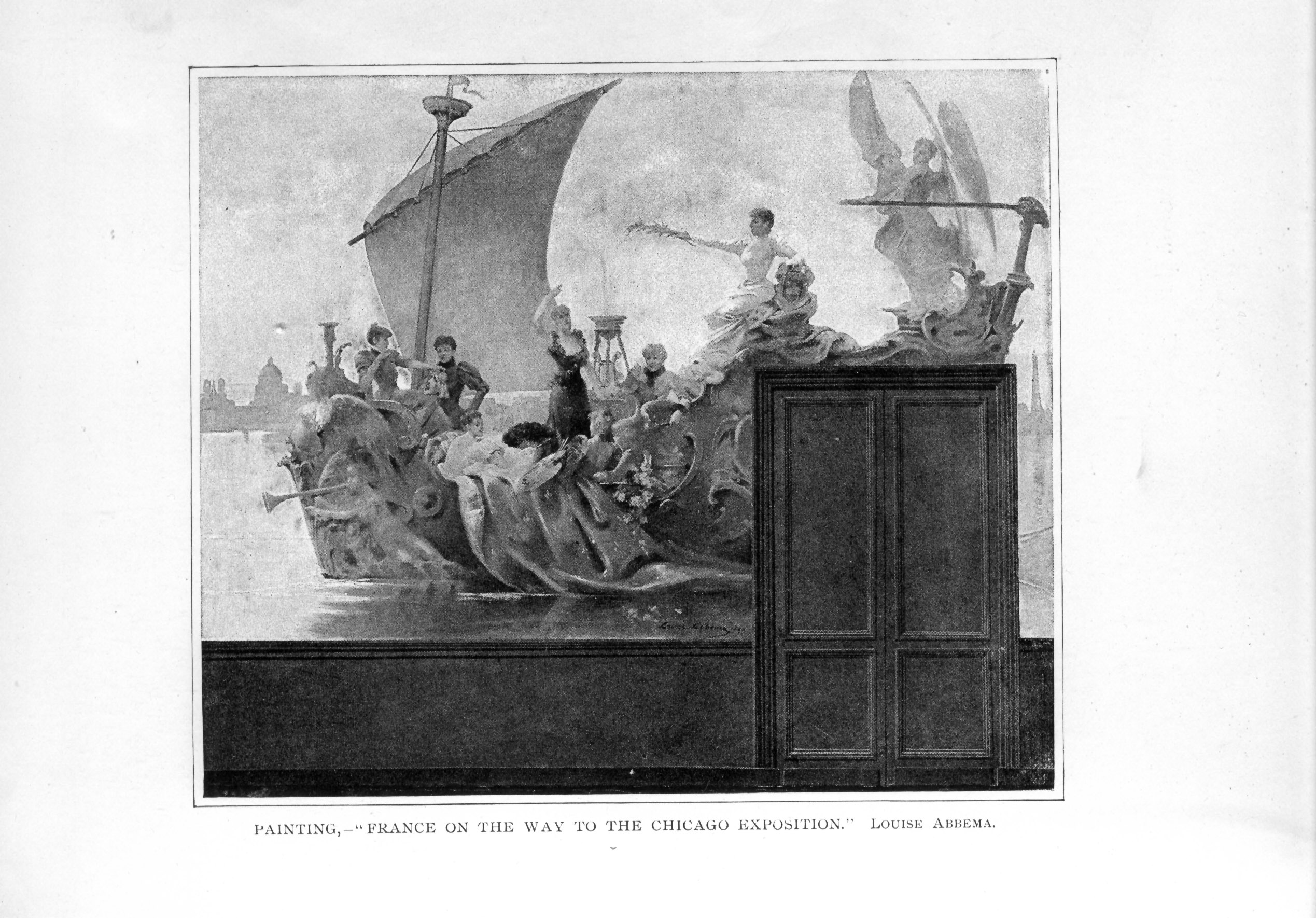
PAINTING—"FRANCE ON THE WAY TO THE CHICAGO EXPOSITION." LOUISE ABBEMA.

FRANCE.
AT the request of the managers of the International Exposition at Chicago, the French government, under date of July 8, 1892, appointed a committee of ladies charged with the preparation of a special woman's exhibit for the Woman's Building. The first act of this committee was to draw up a programme and establish a general classification. But before proceeding to particulars touching the status of woman in France and the conditions affecting her work in industrial, commercial, and agricultural pursuits, her part in education, in the arts, the liberal professions, and the many departments of labor wherein foresight, sympathy, and economy are requisite, the committee has deemed it important to show, by the aid of a certain number of graphic charts, what is in France the true position of women compared with that of men in the different aspects of social life in general; that is to say, in married or single life, in the building up of the family, vitality, etc. It is with this object and in view, especially, of the Exposition at Chicago, that the committee has drawn up the first statistics ever essayed of the demographic part played by women in social economy. Thus an important part of our general statistics has been devoted to this entirely new study.
We have devised a series of charts, chronologically and methodically arranged by departments and districts, in which are shown the proportion of the two sexes in the general population, variation in the date of marriages according to age, locality, and the duration of married life, the number of children therein born, the vitality, longevity, and mortality of women compared with those of men, and so on.
In another department of inquiry the part of women in emigration and immigration has been shown by a certain number of special charts. The committee has elaborated a still more special programme, with a view to classify the diverse economical functions of women. The principal features of this programme are as follows:

PILLOW SHAM.
MME. CROUVEZIER.
FRANCE.
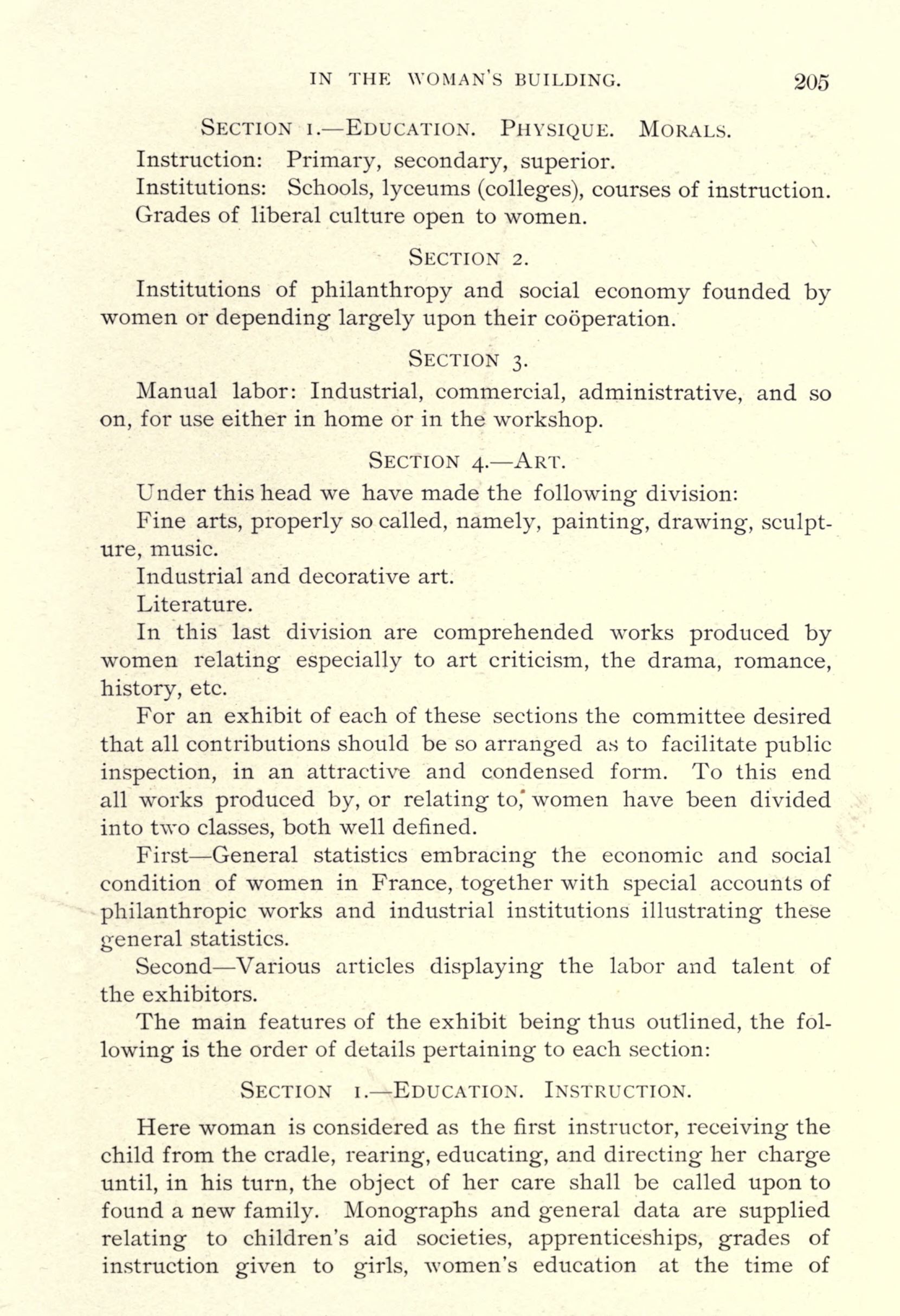
SECTION 1.—EDUCATION. PHYSIQUE. MORALS.
Instruction: Primary, secondary, superior.
Institutions: Schools, lyceums (colleges), courses of instruction.
Grades of liberal culture open to women.
SECTION 2.
Institutions of philanthropy and social economy founded by women or depending largely upon their coöperation.
SECTION 3.
Manual labor: Industrial, commercial, administrative, and so on, for use either in home or in the workshop.
SECTION 4.—ART.
Under this head we have made the following division:
Fine arts, properly so called, namely, painting, drawing, sculpture, music.
Industrial and decorative art.
Literature.
In this last division are comprehended works produced by women relating especially to art criticism, the drama, romance, history, etc.
For an exhibit of each of these sections the committee desired that all contributions should be so arranged as to facilitate public inspection, in an attractive and condensed form. To this end all works produced by, or relating to, women have been divided into two classes, both well defined.
First—General statistics embracing the economic and social condition of women in France, together with special accounts of philanthropic works and industrial institutions illustrating these general statistics.
Second—Various articles displaying the labor and talent of the exhibitors.
The main features of the exhibit being thus outlined, the following is the order of details pertaining to each section:
SECTION 1.—EDUCATION. INSTRUCTION.
Here woman is considered as the first instructor, receiving the child from the cradle, rearing, educating, and directing her charge until, in his turn, the object of her care shall be called upon to found a new family. Monographs and general data are supplied relating to children's aid societies, apprenticeships, grades of instruction given to girls, women's education at the time of
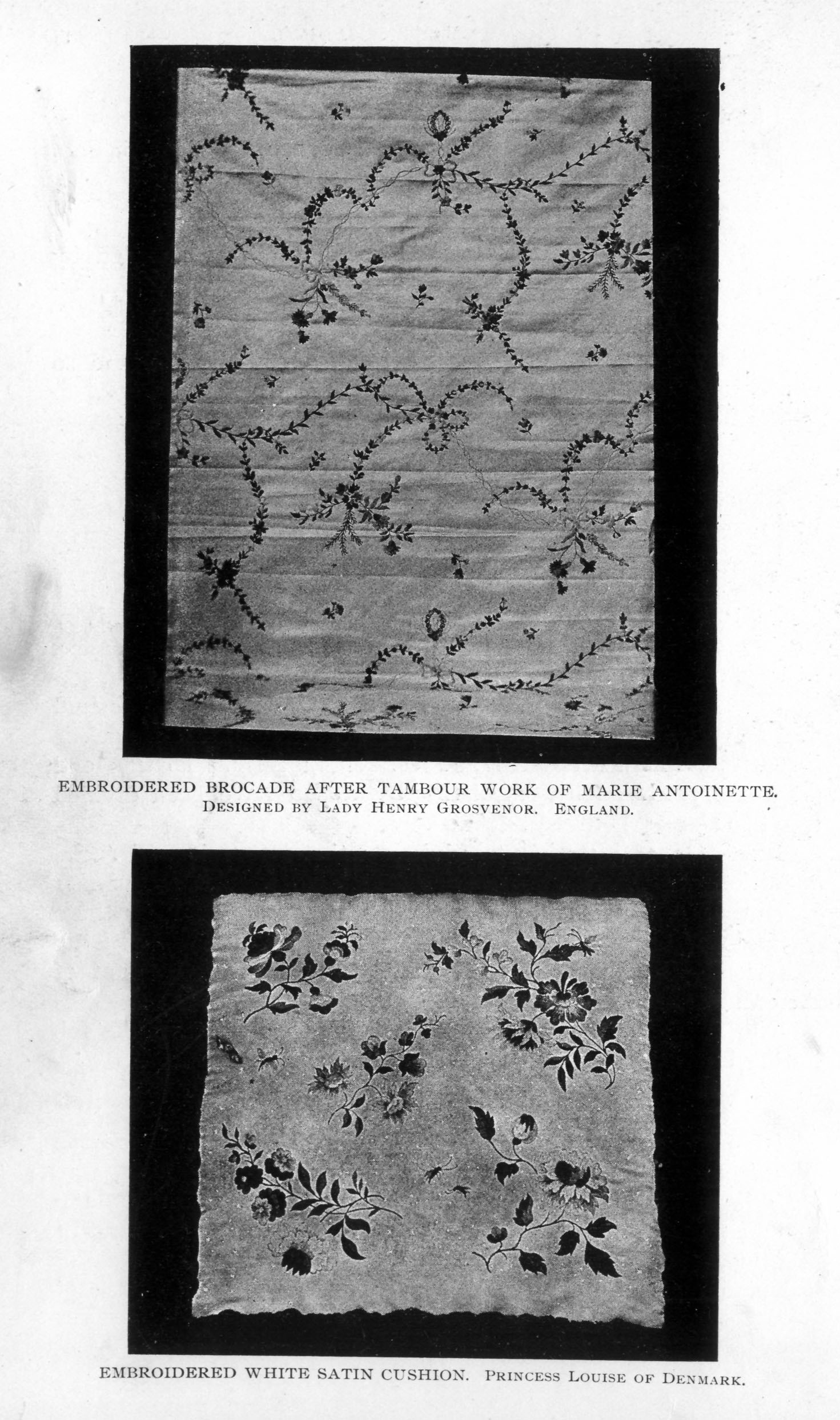
EMBROIDERED BROCADE AFTER TAMBOUR WORK OF MARIE ANTOINETTE.
DESIGNED BY LADY HENRY GROSVENOR.
ENGLAND.
EMBROIDERED WHITE SATIN CUSHION.
PRINCESS LOUISE OF DENMARK.
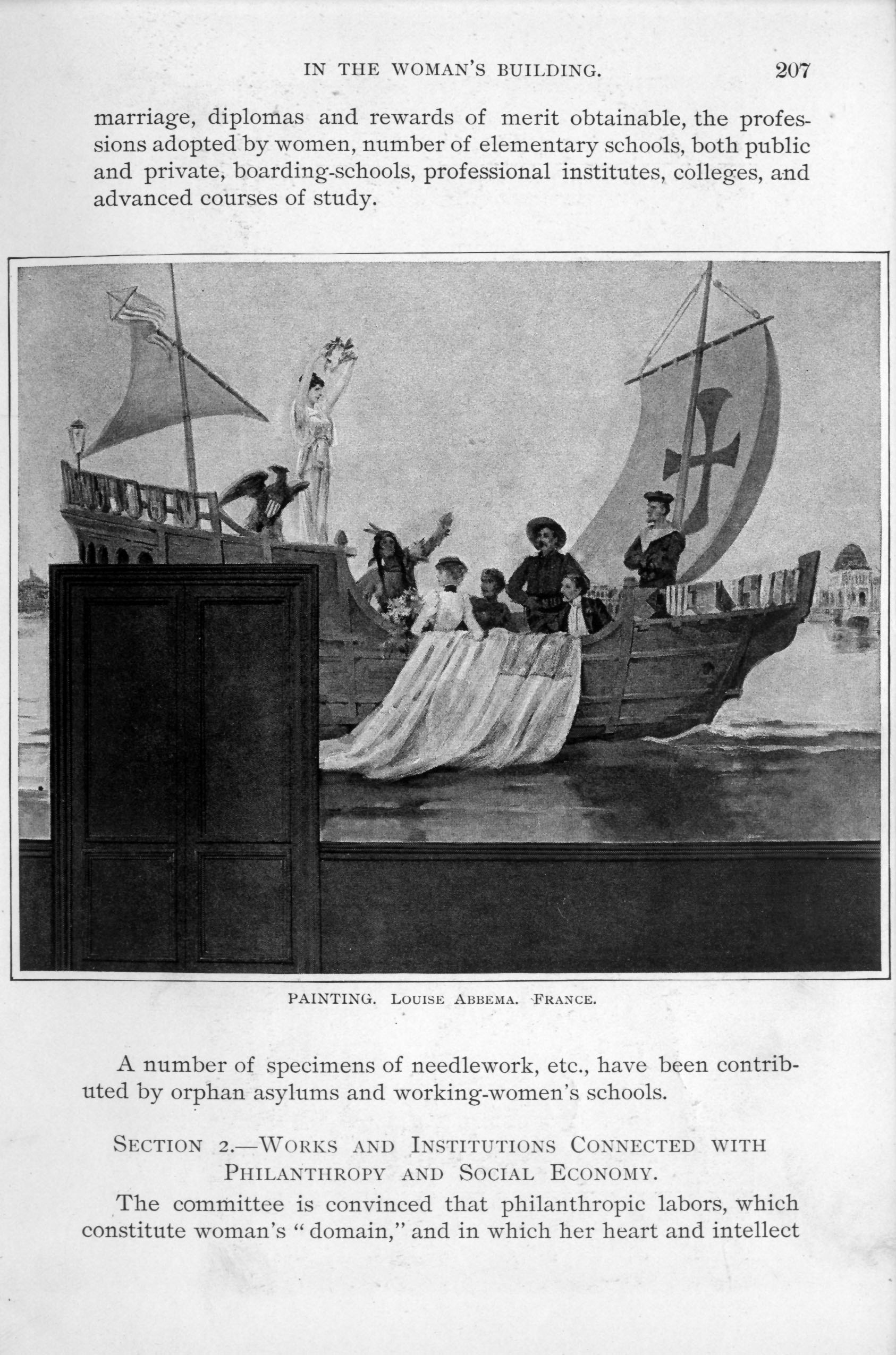
PAINTING.
LOUISE ABBEMA.
FRANCE.
marriage, diplomas and rewards of merit obtainable, the professions adopted by women, number of elementary schools, both public and private, boarding-schools, professional institutes, colleges, and advanced courses of study.
A number of specimens of needlework, etc., have been contributed by orphan asylums and working-women's schools.
SCTION 2.—WORKS AND INSTITUTIONS CONNECTED WITH PHILANTHROPY AND SOCIAL ECONOMY.
The committee is convinced that philanthropic labors, which constitute woman's "domain," and in which her heart and intellect

CONDITION OF WOMEN OF FRANCE IN ALL PROFESSIONS.

find so wide a field of profitable endeavor, will prove of the deepest interest.
This second section is devoted to monographs concerning works of private benevolence, such as crèche societies for the rescue and protection of children, orphan asylums, workmen's infirmaries, the occupation of sick-nurses, sisters of charity, deaconesses; to state works, such as women's hospitals, clinics, societies for the aid of wounded soldiers, and health retreats, houses of refuge, of protection, and of correction; societies in aid of penitent liberated convicts, coöperative societies of mutual help, economy, and protection.
Careful study has been bestowed upon the savings of women, the number of bank-depositors, and the sums placed to the credit of women as compared with those of men, the amount of savings in relation to professions, their average amount, and the progress and growth of women's deposits.
Some of the reports furnished by the above-named establishments, at the request of the committee, have been arranged in the form of mural charts, and others have been gathered in an album, entitled an "Album of Women's Work," for the convenient study of the public.
SECTION 3. WOMEN'S WORK.
The work of women has been classified under the heads of manual, industrial, commercial, administrative, etc.
The committee has carefully ascertained throughout the departments of France the proportion of working-women of all classes, especially those engaged in agriculture and industrial occupations, and the amount of wages gained at different epochs and in different seasons.
The conditions of labor have received particular attention, and with the object of obtaining the desired information a special circular, containing appropriate inquiries, was addressed to those in charge of the principal industrial establishments.
These inquiries regarded the number of women employed, daily hours of labor, wages paid, and societies of social economy intended for the assistance of employes. The replies to these queries are gathered in the album entitled, "Conditions of Labor Among Women.
The tasks intrusted to women in the world of business and the various public and private responsibilities attaching thereto have likewise been classified in the album just spoken of. This includes the services of women in post offices, telegraph and telephone
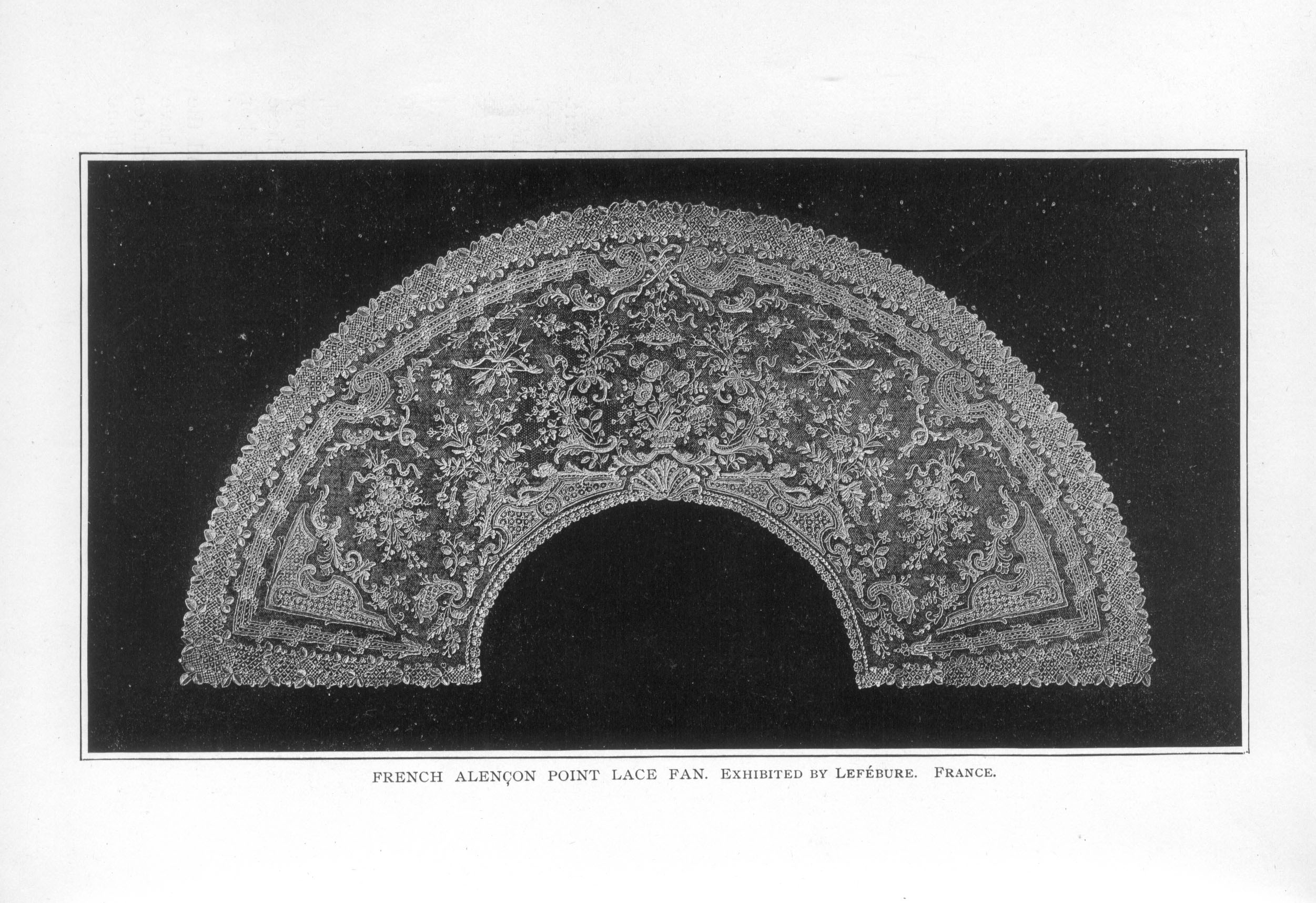
FRENCH ALENÇON POINT LACE FAN.
EXHIBITED BY LEFÉBURE.
FRANCE.
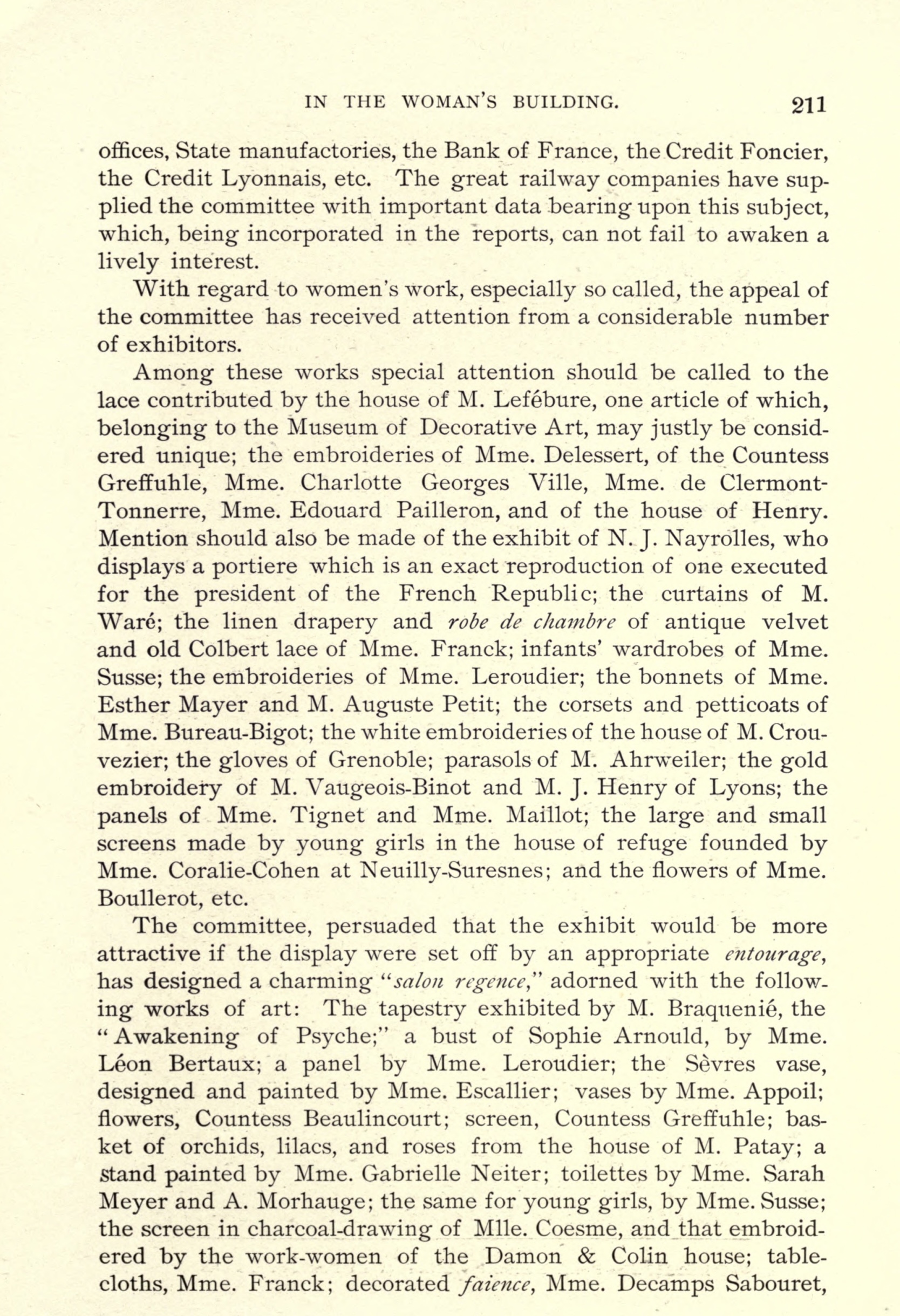
offices, State manufactories, the Bank of France, the Credit Foncier, the Credit Lyonnais, etc. The great railway companies have supplied the committee with important data bearing upon this subject, which, being incorporated in the reports, can not fail to awaken a lively interest.
With regard to women's work, especially so called, the appeal of the committee has received attention from a considerable number of exhibitors.
Among these works special attention should be called to the lace contributed by the house of M. Lefébure, one article of which, belonging to the Museum of Decorative Art, may justly be considered unique; the embroideries of Mme. Delessert, of the Countess Greffuhle, Mme. Charlotte Georges Ville, Mme. de Clermont-Tonnerre, Mme. Edouard Pailleron, and of the house of Henry. Mention should also be made of the exhibit of N. J. Nayrolles, who displays a portiere which is an exact reproduction of one executed for the president of the French Republic; the curtains of M. Waré; the linen drapery and robe de chambre of antique velvet and old Colbert lace of Mme. Franck; infants' wardrobes of Mme. Susse; the embroideries of Mme. Leroudier; the bonnets of Mme. Esther Mayer and M. Auguste Petit; the corsets and petticoats of Mme. Bureau-Bigot; the white embroideries of the house of M. Crouvezier; the gloves of Grenoble; parasols of M. Ahrweiler; the gold embroidery of M. Vaugeois-Binot and M. J. Henry of Lyons; the panels of Mme. Tignet and Mme. Maillot; the large and small screens made by young girls in the house of refuge founded by Mme. Coralie-Cohen at Neuilly-Suresnes; and the flowers of Mme. Boullerot, etc.
The committee, persuaded that the exhibit would be more attractive if the display were set off by an appropriate entourage, has designed a charming "salon regence," adorned with the following works of art: The tapestry exhibited by M. Braquenié, the "Awakening of Psyche;" a bust of Sophie Arnould, by Mme. Léon Bertaux; a panel by Mme. Leroudier; the Sèvres vase, designed and painted by Mme. Escallier; vases by Mme. Appoil; flowers, Countess Beaulincourt; screen, Countess Greffuhle; basket of orchids, lilacs, and roses from the house of M. Patay; a stand painted by Mme. Gabrielle Neiter; toilettes by Mme. Sarah Meyer and A. Morhauge; the same for young girls, by Mme. Susse; the screen in charcoal-drawing of Mlle. Coesme, and that embroidered by the work-women of the Damon & Colin house; tablecloths, Mme. Franck; decorated faience, Mme. Decamps Sabouret,
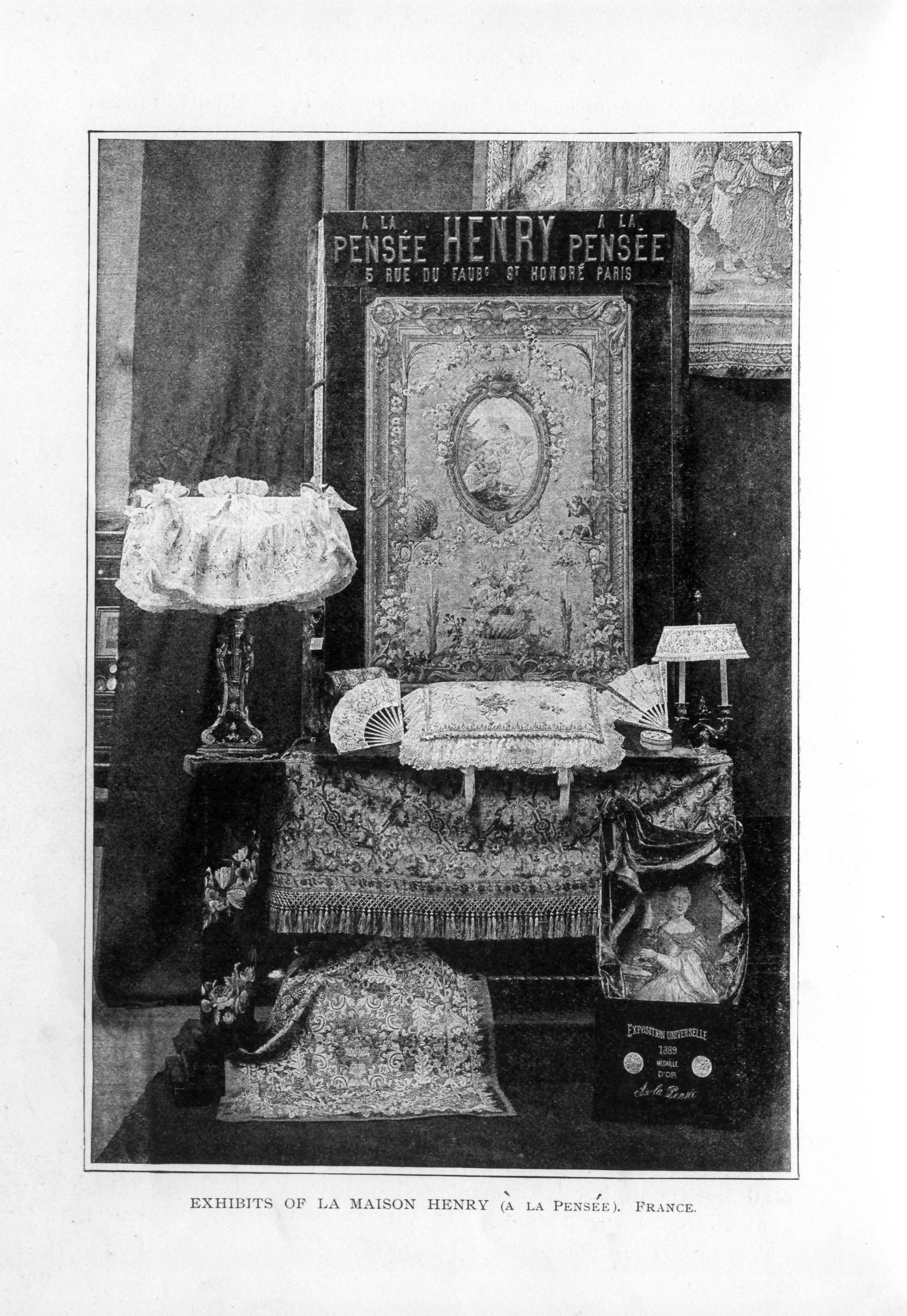
EXHIBITS OF LA MAISON HENRY
(À LA PENSÉE).
FRANCE.
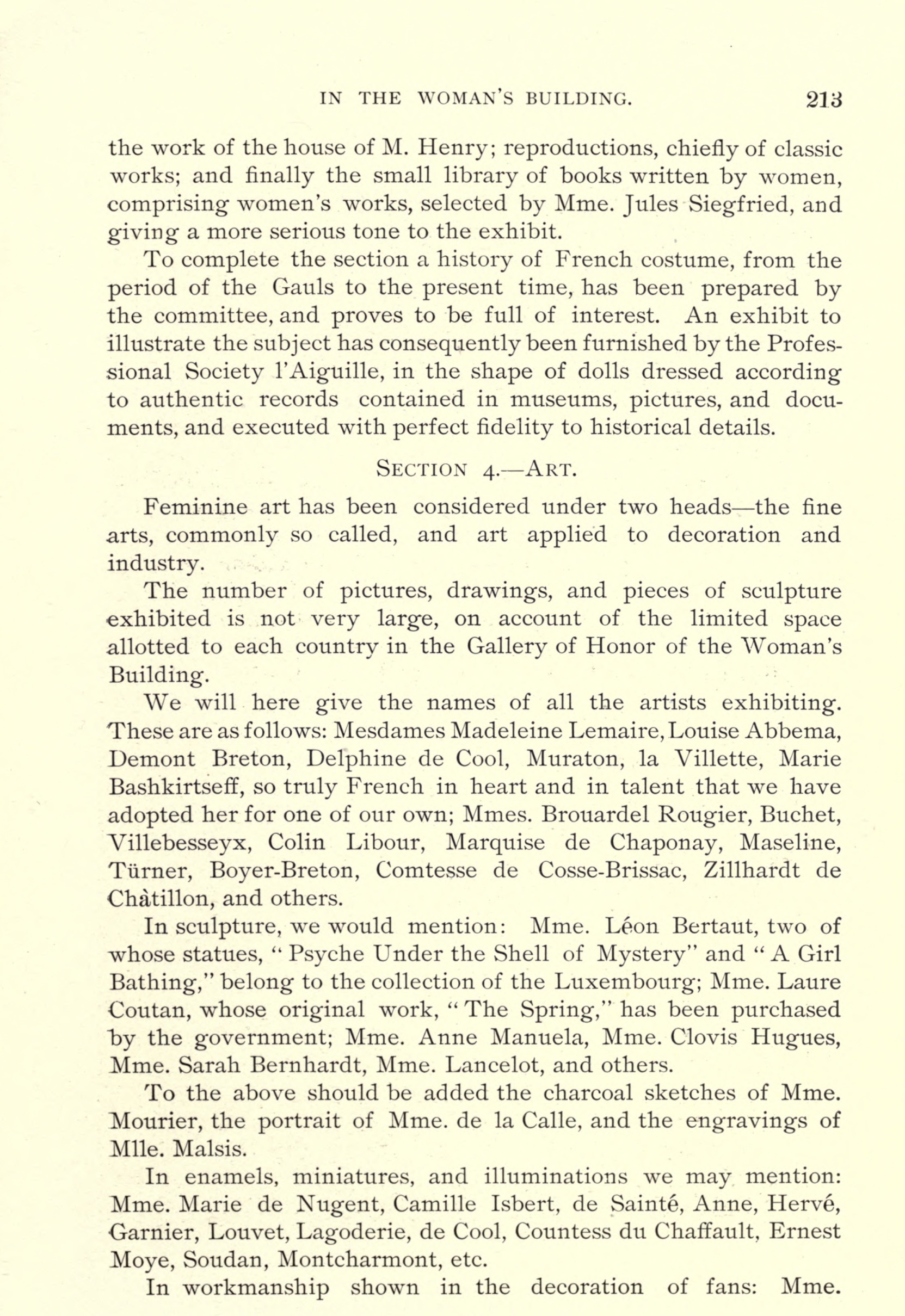
the work of the house of M. Henry; reproductions, chiefly of classic works; and finally the small library of books written by women, comprising women's works, selected by Mme. Jules Siegfried, and giving a more serious tone to the exhibit.
To complete the section a history of French costume, from the period of the Gauls to the present time, has been prepared by the committee, and proves to be full of interest. An exhibit to illustrate the subject has consequently been furnished by the Professional Society l'Aiguille, in the shape of dolls dressed according to authentic records contained in museums, pictures, and documents, and executed with perfect fidelity to historical details.
SECTION 4.—ART.
Feminine art has been considered under two heads—the fine arts, commonly so called, and art applied to decoration and industry.
The number of pictures, drawings, and pieces of sculpture exhibited is not very large, on account of the limited space allotted to each country in the Gallery of Honor of the Woman's Building.
We will here give the names of all the artists exhibiting. These are as follows: Mesdames Madeleine Lemaire, Louise Abbema, Demont Breton, Delphine de Cool, Muraton, la Villette, Marie Bashkirtseff, so truly French in heart and in talent that we have adopted her for one of our own; Mmes. Brouardel Rougier, Buchet, Villebesseyx, Colin Libour, Marquise de Chaponay, Maseline, Türner, Boyer-Breton, Comtesse de Cosse-Brissac, Zillhardt de Chàtillon, and others.
In sculpture, we would mention: Mme. Léon Bertaut, two of whose statues, "Psyche Under the Shell of Mystery" and "A Girl Bathing," belong to the collection of the Luxembourg; Mme. Laure Coutan, whose original work, "The Spring," has been purchased by the government; Mme. Anne Manuela, Mme. Clovis Hugues, Mme. Sarah Bernhardt, Mme. Lancelot, and others.
To the above should be added the charcoal sketches of Mme. Mourier, the portrait of Mme. de la Calle, and the engravings of Mlle. Malsis.
In enamels, miniatures, and illuminations we may mention: Mme. Marie de Nugent, Camille Isbert, de Sainté, Anne, Hervé, Garnier, Louvet, Lagoderie, de Cool, Countess du Chaffault, Ernest Moye, Soudan, Montcharmont, etc.
In workmanship shown in the decoration of fans: Mme.
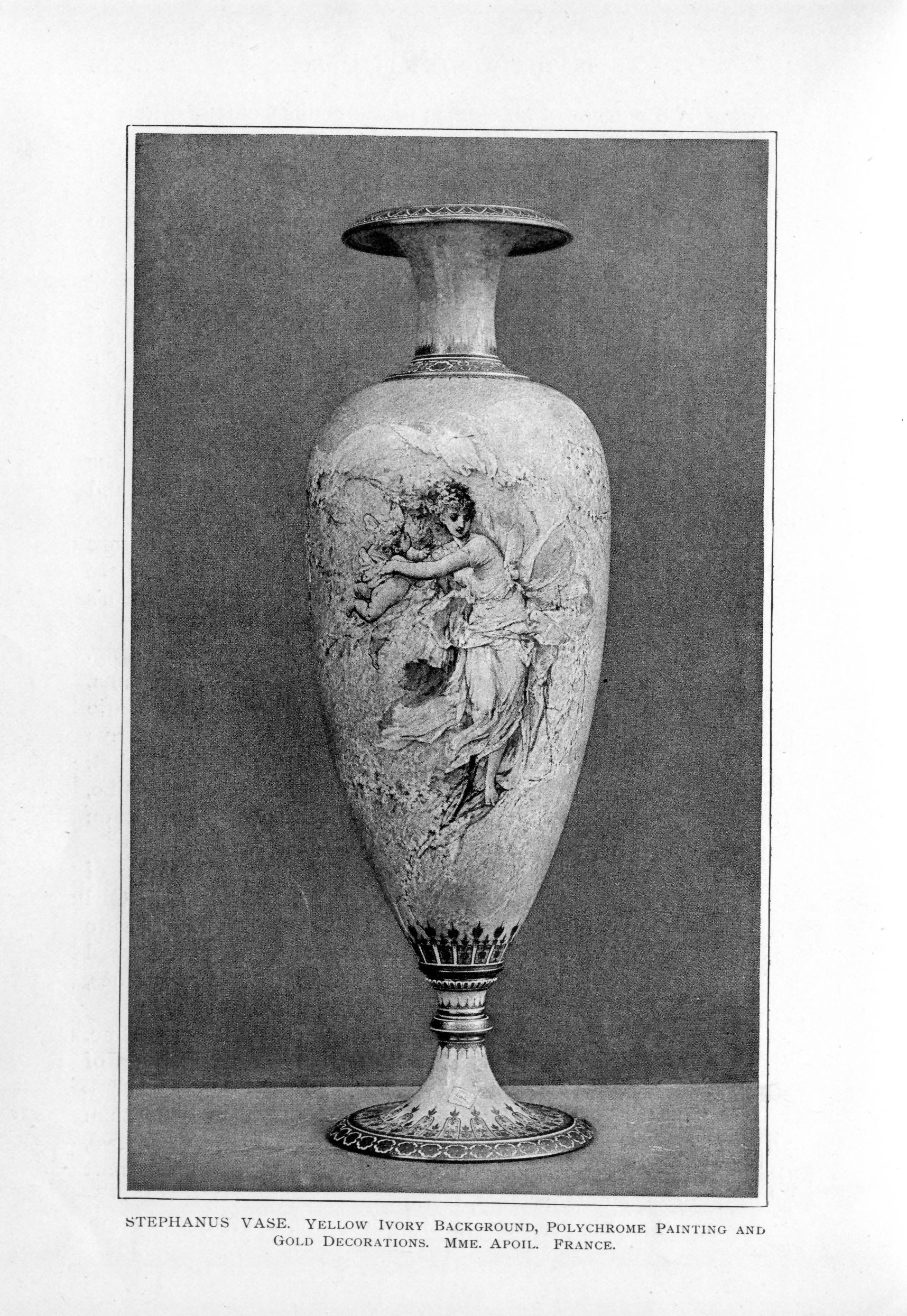
STEPHANUS VASE.
YELLOW IVORY BACKGROUND, POLYCHROME PAINTING AND GOLD DECORATIONS.
MME. APOIL. FRANCE.
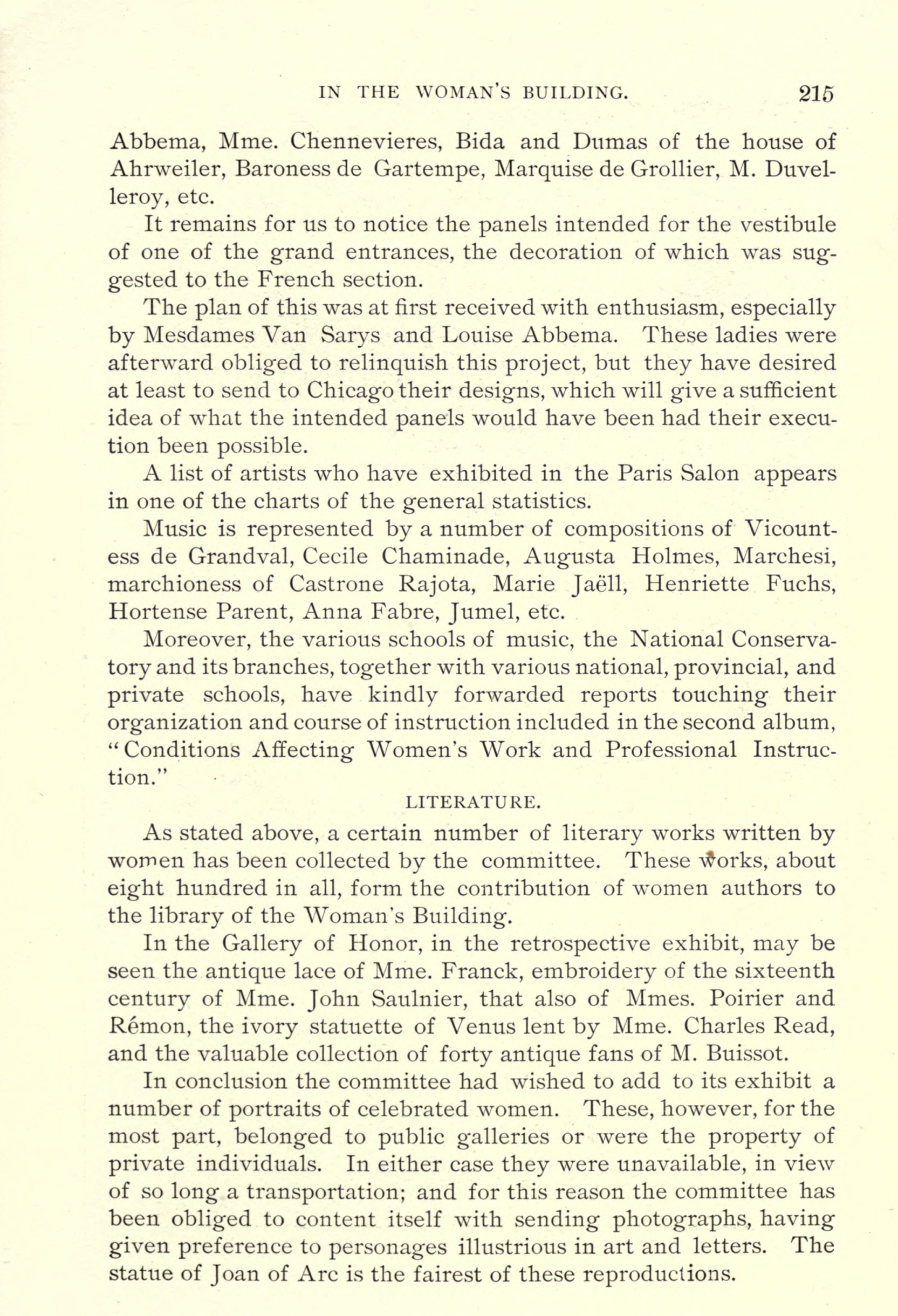
Abbema, Mme. Chennevieres, Bida and Dumas of the house of Ahrweiler, Baroness de Gartempe, Marquise de Grollier, M. Duvelleroy, etc.
It remains for us to notice the panels intended for the vestibule of one of the grand entrances, the decoration of which was suggested to the French section.
The plan of this was at first received with enthusiasm, especially by Mesdames Van Sarys and Louise Abbema. These ladies were afterward obliged to relinquish this project, but they have desired at least to send to Chicago their designs, which will give a sufficient idea of what the intended panels would have been had their execution been possible.
A list of artists who have exhibited in the Paris Salon appears in one of the charts of the general statistics.
Music is represented by a number of compositions of Vicountess de Grandval, Cecile Chaminade, Augusta Holmes, Marchesi, marchioness of Castrone Rajota, Marie Jaëll, Henriette Fuchs, Hortense Parent, Anna Fabre, Jumel, etc.
Moreover, the various schools of music, the National Conservatory and its branches, together with various national, provincial, and private schools, have kindly forwarded reports touching their organization and course of instruction included in the second album, "Conditions Affecting Women's Work and Professional Instruction."
LITERATURE.
As stated above, a certain number of literary works written by women has been collected by the committee. These works, about eight hundred in all, form the contribution of women authors to the library of the Woman's Building.
In the Gallery of Honor, in the retrospective exhibit, may be seen the antique lace of Mme. Franck, embroidery of the sixteenth century of Mme. John Saulnier, that also of Mmes. Poirier and Rémon, the ivory statuette of Venus lent by Mme. Charles Read, and the valuable collection of forty antique fans of M. Buissot.
In conclusion the committee had wished to add to its exhibit a number of portraits of celebrated women. These, however, for the most part, belonged to public galleries or were the property of private individuals. In either case they were unavailable, in view of so long a transportation; and for this reason the committee has been obliged to content itself with sending photographs, having given preference to personages illustrious in art and letters. The statue of Joan of Arc is the fairest of these reproductions.
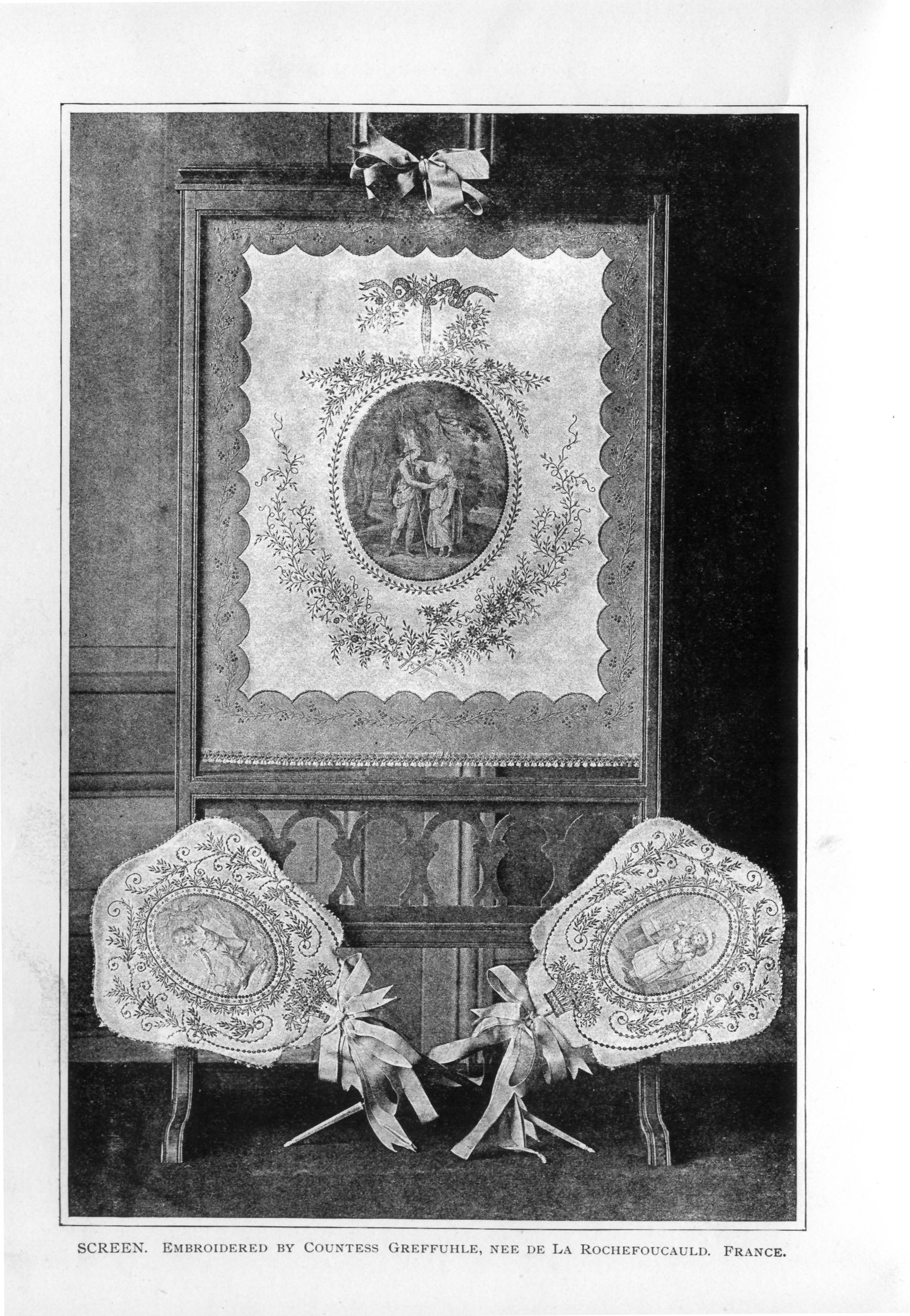
SCREEN. EMBROIDERED BY COUNTESS GREFFUHLE, NEE DE LA ROCHEFOUCAULD.
FRANCE.
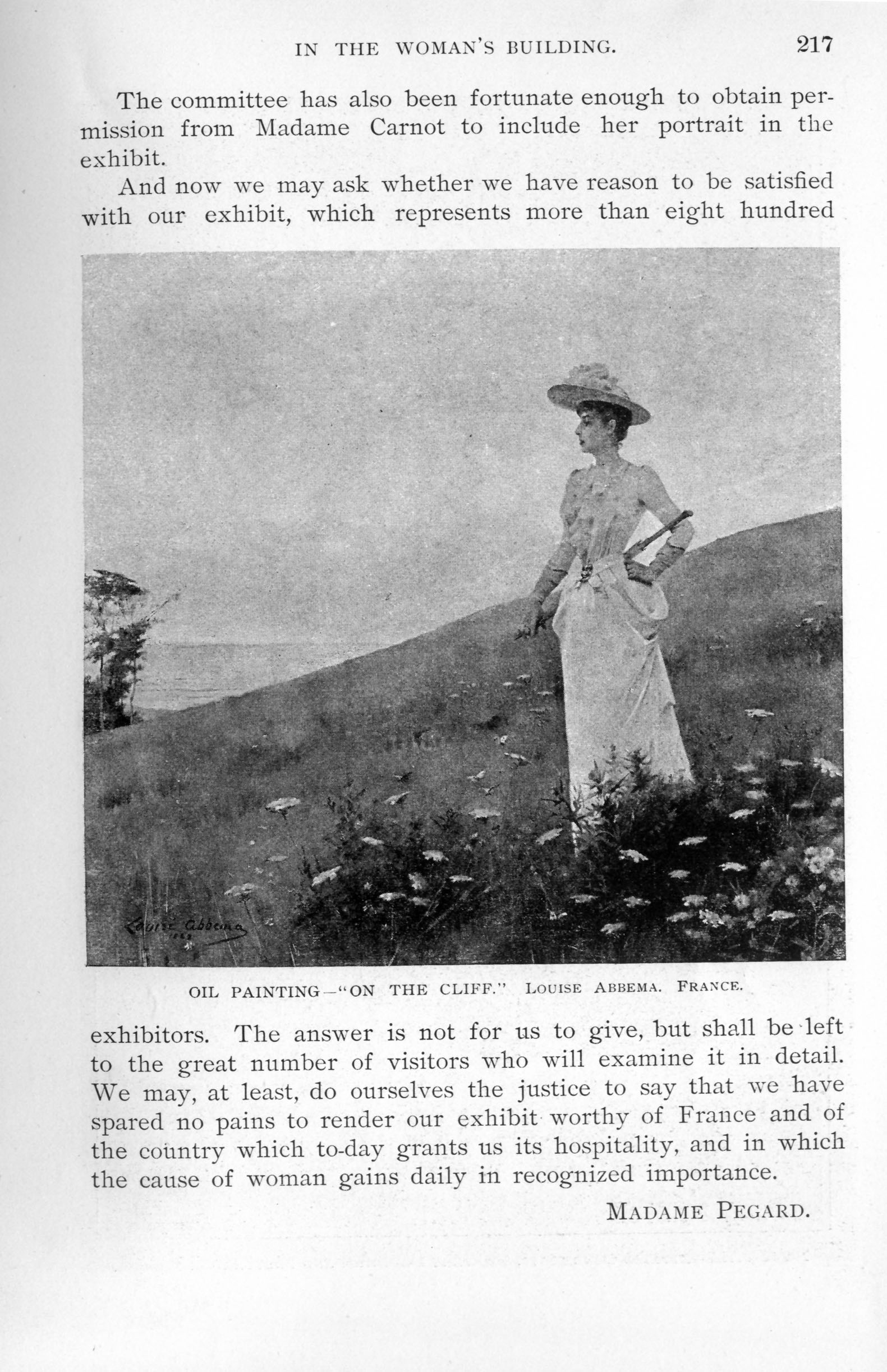
OIL PAINTING—
"ON THE CLIFF."
LOUISE ABBEMA.
FRANCE.
The committee has also been fortunate enough to obtain permission from Madame Carnot to include her portrait in the exhibit.
And now we may ask whether we have reason to be satisfied with our exhibit, which represents more than eight hundred exhibitors. The answer is not for us to give, but shall be left to the great number of visitors who will examine it in detail. We may, at least, do ourselves the justice to say that we have spared no pains to render our exhibit worthy of France and of the country which to-day grants us its hospitality, and in which the cause of woman gains daily in recognized importance.
MADAME PEGARD.

NOVI VASE—
APPLIED ORNAMENTS, FLOWERS AND BIRDS AND POLYCHROME ENAMEL.
E. RICHARD. FRANCE.